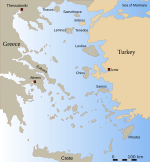Rineia
Native name: Ρήνεια | |
|---|---|
 A bay on Rineia | |
| Geography | |
| Coordinates | 37°24′32″N 25°13′44″E / 37.409°N 25.229°E |
| Archipelago | Cyclades |
| Area | 14 km2 (5.4 sq mi) |
| Highest elevation | 136 m (446 ft) |
| Administration | |
Greece | |
| Region | South Aegean |
| Regional unit | Mykonos |
| Demographics | |
| Population | 0 (2001) |
| Additional information | |
| Postal code | 846 00 |
| Area code(s) | 22890 |
| Vehicle registration | EM |
Rineia, or Rhenea (Ρήνεια), is a Greek island in the Cyclades. It lies just west of the island of Delos and further southwest of the island of Mykonos, of which it and Delos are administratively a part. Its area is 14 km2 (5 sq mi). It had a small population until the 1980s, but is currently uninhabited.[citation needed]
In ancient times, the island was known as Rheneia (Ancient Greek: Ῥήνεια), and was part of both the Delian League[1] and the Roman Empire.[2] In the 6th century BC, it was subdued by the tyrant Polycrates of Samos and dedicated to the Delian Apollo.[1] The southern half of Rheneia was the necropolis of Delos.[citation needed] In the sixth year of the Peloponnesian War (426 BCE), the Athenians "purified" Delos by removing all its tombs and prohibiting burials there. Future births and deaths on Delos were prohibited—pregnant women and people close to death were to be carried over to Rheneia.[1][3]
References
[edit]- ^ a b c Thucydides 1874, p. 104.
- ^ Lund University. Digital Atlas of the Roman Empire.
- ^ Bury 1975, p. 267.
Sources
[edit]- Bury, J. B. (1975). A History of Greece. Macmillan. ISBN 978-0-333-15493-9.
- Thucydides (1874) [431 BC]. Crawley, Richard (ed.). . Oxford University Press.
External links
[edit]- Official website of Municipality of Mykonos (in English and Greek)


